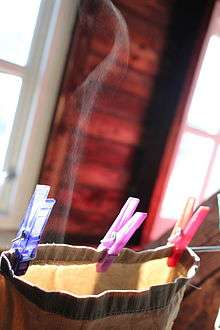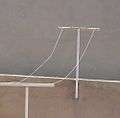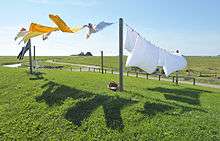Clothes line
A clothes line or washing line is any type of rope, cord, or twine that has been stretched between two points (e.g. two sticks), outside or indoors, above the level of the ground. Clothing that has recently been washed is hung along the line to dry, using clothes pegs or clothespins. Washing lines are attached either from a post or a wall, and are frequently located in back gardens, or on balconies. Longer washing lines often have props holding up sections in the middle due to the weight of the usually wet clothing.
More elaborate rotary washing lines save space and are typically retractable and square or triangular in shape, with multiple lines being used (such as the Hills Hoist from Australia). Some can be folded up when not in use (although there is a very minor hazard of getting fingers caught, so there is usually a safety button).
In Scotland, many tenement buildings have a "drying green", which is a communal area predominantly used for clothes lines – it may also be used as a recreational space - as well as a clothes horse connected to a pulley system inside which can be used in the frequently cold winter weather.
Comparison
Advantages
- Saves money[1][2]
- Zero greenhouse gas emissions per load[1][2][3] (2 kg CO2eq of greenhouse gas emissions from the average mechanical clothes dryer per load)[3]
- Less fabric wear and tear[2]
- Laundry items do not shrink (hot air from a mechanical clothes dryer may shrink items)
- No static cling and no perfume smells throughout the neighborhood from fabric softener and anti-static dryer sheets.
- Laundry items stay softer to the touch (mechanical clothes dryers tend to remove short, soft, fine fibers), and may be less wrinkled
- Laundry items often do not need ironing if line dried in a breeze
- Avoids the potential of airborne lint and reduced air quality
- Eliminates the noise from a mechanical clothes dryer
- Does not vent indoor air to the outside and waste the large volume of conditioned (heated or cooled) air that a mechanical dryer's blower does.
- For a simple line drying arrangement (rope and clothes pins) the repair and replacement costs are about $20.00 per 1,000 loads of laundry or 2 cents per load. For non-commercial mechanical clothes drying the repair and replacement costs (including labor expenses) are about $200.00 per 1,000 loads of laundry or 20 cents per load.
Disadvantages
- Putting laundry on a line usually takes more time than putting it into a mechanical dryer (as laundry items have to be hung up and fixed one by one).
- Laundry items need to be hung indoors during rainy weather, or may get wet if the weather changes.
- Neighbours may find it aesthetically unpleasant[1]
- Exposing dirty laundry can lessen privacy, showing information about inhabitants' living habits.
- Risk of theft or vandalism of clothes
- Environmental contaminants such as soil, dust, smoke, automotive or industrial pollutants, pollen and bird and animal droppings can come in contact with clothing.
- Clothespins can leave imprints (including rust from the spring) on the clothes.
Drying laundry indoors

Laundry may be dried indoors rather than outdoors for a variety of reasons including:
- inclement weather
- physical disability
- lack of space for a line
- reduce the damage to fabrics from sun's UV rays
- legal restrictions[4]
- to raise the humidity level indoors, and lower the air temperature indoors
- convenience
- to preserve privacy
Several types of devices are available for indoor drying. A drying rack or clotheshorse can help save space in an apartment, or clothes lines can be strung in the basement during the winter. Small loads can simply be draped over furniture or a shower curtain pole. The drying time indoors will typically be longer than outdoor drying because of the lack of direct solar radiation and the convective assistance of the wind.
The evaporation of the moisture from the clothes will cool the indoor air and increase the humidity level, which may or may not be desirable. In cold, dry weather, moderate increases in humidity make most people feel more comfortable. In warm weather, increased humidity makes most people feel even hotter. Increased humidity can also increase growth of fungi, which can cause health problems.
An average-sized wash load will convert approximately 4965 kilojoules of ambient heat into latent heat that is stored in the evaporated water, as follows. A typical 4 kg load of laundry can contain 2.2 kg of water, after being spun in a laundry machine.[5] To determine how much heat has been converted in drying a load of laundry, weigh the clothes when they are wet and then again after the clothes have dried. The difference is the weight of the water that was evaporated from them. Multiply that weight in kg by 2,257 kJ/kg,[6] which is the heat of vaporization per kilogram, to obtain the number of kilojoules that went into evaporating the water, or multiply by 0.6250 kWh/kg to get kilowatt-hours. (Note: If the moisture later condenses inside the house, the latent heat will be converted back into ambient heat which could increase the temperature of the air in the room slightly.) [7] To obtain a good approximation of the effect this would have in a particular situation, the process can be traced on a psychrometric chart.
Factors that determine the drying duration
Various factors determine the duration of drying and can help to decide rather to use a drier or a clothes line[8]
- The environmental temperature - increase of temperature decreases the drying duration
- The environmental humidity - decrease of humidity will decrease the drying duration
- Wind velocity - Sometimes people put a fan near the clothes when drying them indoors
- Direct sun - usually only the external line will be exposed to direct sun, so usually people put the thickest clothes on the most external line.
- Cloth thickness
Drying laundry in freezing conditions
Laundry may be dried outdoors when the temperature is well below the freezing point. First, the moisture in the laundry items will freeze and the clothing will become stiff. Then the frost on the clothes will sublimate into the air, leaving the items dry. It takes a long time and it is usually much quicker to dry them indoors; however, indoor drying removes heat from the air so it is a trade-off between speed and energy efficiency.
Controversy in North America
Controversy surrounding the use of clothes lines has prompted many governments to pass "right-to-dry" laws allowing their use.[1] According to Ian Urbina, a reporter for The New York Times, "the majority of the 60 million people who now live in the country’s roughly 300,000 private communities" are forbidden from using outdoor clothes lines.[9]
As of August 2013, the states of Florida, Colorado,[10][11][12] Hawaii,[13] Arizona, California, Illinois, Indiana, Louisiana, Maine, Maryland, Massachusetts, Nevada, New Mexico, North Carolina, Oregon, Texas, Vermont, Virginia, and Wisconsin had passed laws forbidding bans on clothes lines, with Utah allowing local jurisdictions to forbid such bans.[14] At least eight states restrict homeowners' associations from forbidding the installation of solar-energy systems, and lawyers have debated whether or not those laws might apply to clothes lines. A British filmmaker, Steven Lake, was planning to release a documentary in 2011 titled Drying for Freedom about the clothes-line controversy in the United States.[9]
In Canada, the province of Nova Scotia's first NDP government passed An Act to Prevent Prohibitions on the Use of Clotheslines on December 10, 2010 to allow all homeowners in the province to use clotheslines, regardless of restrictive covenants.[15] The province of Ontario lifted bans on clothes lines in 2008.[16]
Some other affluent suburban municipalities such as Hampstead, Québec or Outremont, Québec also prohibit clotheslines.
Images
 Clothes pins (or pegs) on a clothes line
Clothes pins (or pegs) on a clothes line Pegs on a clothes line
Pegs on a clothes line Washing line in Iceland
Washing line in Iceland T clothes line
T clothes line Clothes lines in New York City, from a 1904 postcard
Clothes lines in New York City, from a 1904 postcard
- Clotheslines fiber made with polyurethane
 Clothesline in El Jadida
Clothesline in El Jadida- Retractable clothes line
 A folding umbrella-style clothes line
A folding umbrella-style clothes line
See also
- Drying cabinet
- Enthalpy of vaporization
- Sheila Maid
- Penman equation
- Project Laundry List, New-Hampshire, US, organisation to encourage outdoor drying
- Gilbert Toyne
References
- 1 2 3 4 Rosenthal, Elisabeth (April 17, 2008), "A Line in the Yard: The Battle Over the Right to Dry Outside", New York Times
- 1 2 3 Aun, Leslie M. (August 17, 2006), "Nature's Dryer Revisited", Washington Post
- 1 2 Environmental impact of a clothes dryer and a clothes line, ecofx, January 10, 2008
- ↑ http://www.abajournal.com/news/article/20_right_to_dry_states_outlaw_clothesline_bans_is_yours_among_them
- ↑ http://www.explainthatstuff.com/how-clothes-tumble-dryers-work.html
- ↑ http://www.engineeringtoolbox.com/fluids-evaporation-latent-heat-d_147.html
- ↑ Diamond, Sheldon R. (1970). Fundamental Concepts of Modern Physics. USA: AMSCO School Publications, Inc. pp. 205. "During evaporation... The surroundings thereby become the ultimate source of the energy required to change the phase of [water] from liquid to gas."
- ↑ http://www.copatents.com/en/drycloth
- 1 2 Urbina, Ian, "Debate Follows Bills to Remove Bans on Clotheslines", The New York Times, p 23, October 11, 2009
- ↑ "Real Estate News, Mortgage Rates, Buy, Sell or Rent a Home - Wall Street Journal - Wsj.com". Realestatejournal.com. October 3, 2002. Retrieved February 10, 2013.
- ↑ Chaker, Anne Marie (September 18, 2007) "The Right to Dry", The Wall Street Journal.
- ↑ Colorado Governor's Energy Office HOA Bill – HB 1270
- ↑ Hawaii State Legislature. "Haw. Rev. Stat. § 196-8.5". Retrieved July 8, 2015.
- ↑ Neil, Martha (August 14, 2013). "19 'right to dry' states outlaw clothesline bans; is yours among them?". ABA Journal. Retrieved August 23, 2016.
- ↑ "Nova Scotia legislature". Nslegislature.ca. Retrieved February 10, 2013.
- ↑ "Ontario premier lifts outdoor-clothesline ban". Ctv.ca. April 18, 2008. Retrieved February 10, 2013.
External links
| Wikimedia Commons has media related to Clothes lines. |
- Article about washing lines and clothes pegs
- Project Laundry List
- "Instructables" article on minimizing the work involved in using a clothes line
